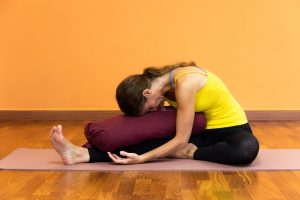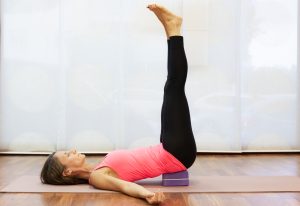Balance — it’s a word we hear all the time. We often use it to refer to work-life balance, financial stability, and even our emotional state. But what about when it comes to your yoga practice?
Yoga has two main types of practices: yin and yang. Popular rhythmic and repetitive flows, such as those performed in hatha, vinyasa, and power yoga, are types of yang yoga that are more active, engage the muscles, build strength, and stimulate blood flow.
Meanwhile, yin yoga is characterized by rest and long postural holds. In many circles, it’s even known as “lazy” yoga. However, if you’ve ever stepped foot into a yin yoga class, you might realize that holding a pose for several minutes isn’t as easy as it looks.
It requires mindfulness and the ability to be still for long durations. This can be difficult for beginners of yin yoga, but it’s well worth the benefits. Yin yoga can help improve your range of motion, enhance your emotional well-being, and much more.
In this guide, we explore the benefits of yin yoga, what you can expect to learn in a yin class, and how to start a yin yoga practice using Insight Timer’s wide range of yoga and meditation resources.
Key takeaways
- Yin yoga is a type of yoga that utilizes stillness, meditation, and sustained poses to achieve balance between the body, mind, and soul.
- The benefits of yin yoga include increased flexibility, reduced stress, decreased anxiety, improved blood flow, and more.
- While yin yoga is suitable for almost anyone, individuals with pre-existing joint conditions or those who are pregnant should consult with a doctor first.
What is yin yoga?
Yin yoga involves holding the same postures for 2 to 5 minutes. It trains the mind to slow down and let go while also promoting the elongation of the connective tissue in the body.
The modern practice of yin yoga has ancient roots, drawing inspiration from Chinese Taoist philosophies. Taoist yoga uses similar postures to help the body find stillness during meditation. These techniques have also been used in kung fu training for millennia.
In the 1970s, Paulie Zink was the first to introduce this style of yoga to the Western world. He taught these practices to his students as part of his hatha instruction. But it was actually one of Paulie’s students who took yin yoga to the global stage.
Paul Grilley blended Zink’s teachings with hatha yoga and the Chinese meridians. Eventually, this became what we now know as yin yoga. Today, Paul Grilley and his student Sarah Powers are regarded as some of the world’s leading yin yoga teachers.

What sets yin yoga apart from restorative yoga?
To those familiar with restorative yoga, yin yoga might sound similar. Both use props, like bolsters and blocks, to help enhance relaxation, but their focus slightly differs.
Restorative yoga focuses solely on releasing mind and body tension. It guides you toward softness in your poses and relaxation in both the body and the mind. Yin yoga, on the other hand, is more about stretching connective tissue, such as fascia and ligaments. This means finding a balance between the intensity and gentleness of a pose.
The key principles of yin yoga
Yin yoga revolves around 3 main principles. These include:
- Finding your edge: This refers to moving into a pose at an appropriate depth for you and your body. This can vary from day to day, depending on your emotional state, hydration, recent workouts, and more.
- Maintaining stillness: The goal is to remain as still as possible. It might feel foreign at first, and you may be tempted to fidget, but with practice, it gets easier.
- Holding the pose: Each pose is held for 3 to 5 minutes. When holding a pose for an extended period of time, finding a focal point, such as your breathing, can be helpful.
Moving and fidgeting are completely natural for beginners who are just learning the practice. You may find it difficult to hold a pose initially, but this will subside over time. Some adjustments may also be necessary if you notice a pose doesn’t feel quite right.
Stretch it out: Insight Timer offers top-rated yin yoga meditations for all abilities and intensities. Take a look to get started.
What are the benefits of yin yoga?
Yin yoga offers a great way to achieve balance between the mind, body, and soul. Some of the main benefits help us to:
1. Lengthen connective tissue
Fascia covers all muscle tissue throughout the body. Pain and injury can occur when this fascia becomes “stuck.” Often referred to as adhesions, this regularly happens after micro-injuries or lack of activity. You’ll notice limited movement and range of motion in these areas. Some people also complain about stiffness or aching.
By regularly stretching this tissue through a yin yoga practice, you can reduce your risk of pain. It not only releases these tight spots but also reduces inflammation, according to research. As a result, your body becomes more resilient, meaning you can lead a healthier, pain-free life.
2. Improve flexibility
Flexibility becomes limited due to the fascia adhesions mentioned above. But it can also decrease when we don’t stretch consistently, again leading to an increased risk of injury and pain.
Yin yoga doesn’t just stretch the fascia tissue. It also stretches the ligaments and tendons, which can enhance your range of motion and mobility, too.
3. Reduce stress and anxiety
Where yang yoga might leave you feeling invigorated and sweaty, yin yoga improves your well-being from another direction. Research shows that this form of yoga reduces stress, limiting negative health consequences due to chronically high stress. In this same study, participants experienced decreased anxiety.
In other words, yin yoga can help improve your physical and mental states. It does this through physiological relaxation and increased mindfulness. With your mind untethered from constant worrying, you may also find you have greater mental clarity and concentration.
4. Improve blood flow
Yin poses frequently require a focal point, such as your breath, to maintain stillness. In a yin class, your yoga instructor will often redirect your thoughts toward your breath. But this isn’t just about your mental resilience.
Slow and deep breathing also enhances blood flow, ensuring all areas of the body get the nutrients and oxygen they require. Biologically, deep breathing activates the parasympathetic nervous system (our rest and digest response), furthering relaxation. This helps release tense muscles, allowing the blood to flow through your body more easily.

What can you expect in a yin yoga class?
Yin classes generally run between 60 to 90 minutes. In some cases, the yoga teacher might suggest setting an intention before beginning your practice. Either way, you might want to do this yourself to help maintain focus throughout the long holds.
Throughout the class, the teacher generally guides you through each pose with demonstrations and cues. Yin poses often work the lower body, but this doesn’t mean your instructor won’t incorporate upper body work.
Most times, a yin class works to lengthen common areas of tension, such as the hips, lower back, and pelvis.
Ready to try a yin yoga class? We recommend starting with a guided practice that’s suitable for all levels of experience, like Letting Go with Yin Yoga.
What are some beginner yin poses with bolsters and blocks?
Common poses incorporating bolsters and blocks include:
- Child’s pose
- Pigeon pose
- Upside down dragon
- Sphinx
- Butterfly pose
- Bridge
If you prefer to practice yoga at home, consider selecting your poses before you start. Choose ones that target areas of tension in your body. For example, if you recently performed a challenging leg workout, hip openers, like the butterfly pose, are great options to re-calibrate. From here, you can use bolsters or blocks as needed. In place of bolsters, pillows can assist you as well.
What happens in the body after yin yoga?
The most common noticeable change is a release in tension. Post-yin yoga, some may also describe sensations of warmth, tingling, or expansion.
At the same time, it’s completely normal to feel sore the next day. While it may be referred to as “lazy” yoga, it still works and challenges the body — just in a different way.
Who is yin yoga for?
Yin yoga is an excellent choice for yoga newbies or individuals looking to strike a balance with their regular exercise routine. It can also help those with injuries or chronic conditions causing pain. The slow movements of this style of yoga make it less likely to re-aggravate existing issues or cause new ones.
Fortunately, many yin poses can also be modified. Your yoga teacher can instruct you on options and help guide you toward the best positions.
And remember to always listen to your body—it knows best.
Who should avoid yin yoga?
Yin yoga might not be suitable for:
- Pregnant individuals
- Those with hypermobility problems
- People diagnosed with osteoporosis
If you’re unsure about practicing yin yoga, be sure to consult with your doctor. They can offer guidance on what’s best for your body and health.
Yin yoga: the balanced approach you’ve been missing?
Multiple eastern medicine traditions have long insisted that the body and mind are connected and that we can heal one by working on the other. Western trauma researchers have come to a similar conclusion: Trauma and emotions can mask themselves as physical tension or pain within the body’s tissues.
While not everyone’s physical limitations are a result of deeper emotional blockages and wounds, almost anyone can benefit from the practice of yin yoga. By helping the body’s energy flow, yin yoga helps create a balance between the body, mind, and soul.
For more support in creating your yin yoga practice, use Insight Timer’s courses and guided meditations. Whether you’re just starting out or looking for newfound inspiration, Insight Timer gives you access to over 18,000 of the world’s leading teachers and a growing community of like-minded individuals.
Yin yoga FAQ
How many yin yoga poses are there?
There are 26 different yin poses, offering you a variety of movements to incorporate into your regular practice.
How long should you hold poses in yin yoga for maximum benefit?
For maximum benefit, hold each yin yoga pose for at least 3 to 5 minutes. And don’t forget to do it on both sides!
Can yin yoga improve flexibility and joint health?
Yes, yin yoga improves flexibility, enhancing joint health and overall mobility. Since each pose is held for a longer duration than in other yoga styles, deep connective tissues experience greater elongation.
Is yin yoga good for joint pain?
It depends. Yin yoga can be a great choice for joint pain since it involves slow and intentional movements. But this doesn’t mean it’s appropriate for everyone. If you have any concerns or a pre-existing joint condition, consider talking to your doctor before getting started.
References
- Zügel, M., Maganaris, C. N., Wilke, J., Jurkat-Rott, K., Klingler, W., Wearing, S. C., Findley, T., Barbe, M. F., Steinacker, J. M., Vleeming, A., Bloch, W., Schleip, R., & Hodges, P. W. (2018). Fascial tissue research in sports medicine: from molecules to tissue adaptation, injury and diagnostics: consensus statement. British journal of sports medicine, 52(23), 1497. https://doi.org/10.1136/bjsports-2018-099308
- Daukantaitė, D., Tellhed, U., Maddux, R. E., Svensson, T., & Melander, O. (2018). Five-week yin yoga-based interventions decreased plasma adrenomedullin and increased psychological health in stressed adults: A randomized controlled trial. PloS one, 13(7), e0200518. https://doi.org/10.1371/journal.pone.0200518
- Russo, M. A., Santarelli, D. M., & O’Rourke, D. (2017). The physiological effects of slow breathing in the healthy human. Breathe (Sheffield, England), 13(4), 298–309. https://doi.org/10.1183/20734735.009817
- Ho, J. M. C., Chan, A. S. W., Luk, C. Y., & Tang, P. M. K. (2021). Book Review: The Body Keeps the Score: Brain, Mind, and Body in the Healing of Trauma. Frontiers in Psychology, 12, 704974. https://doi.org/10.3389/fpsyg.2021.704974




-1.jpg)


